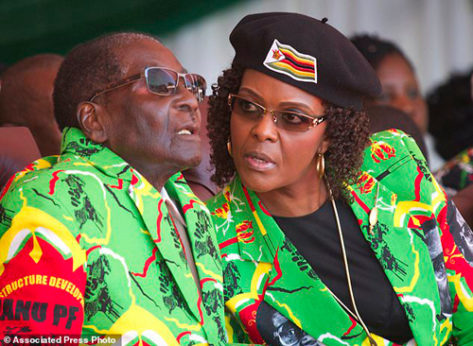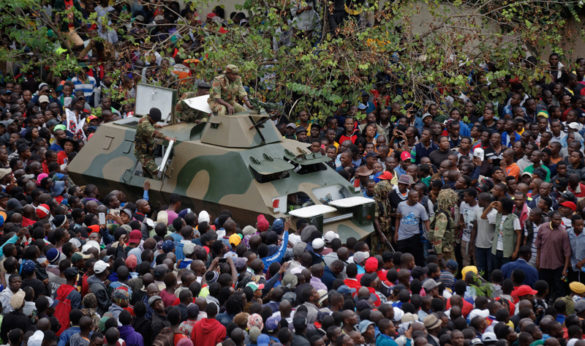
On Wednesday, Nov. 15, the Zimbabwean military placed the country’s long-time president, Robert Mugabe, under house arrest and detained several other senior government officials. At press time, a deadline issued by his party for Mugabe to resign has passed with no statement from the president.
Much mainstream reporting has focused on the personal intrigues and power struggles involving the president, his wife Grace Mugabe, and a recently-deposed vice president, Emmerson Mnangagwa. The long history of Zimbabwe, which prior to 1980 was an apartheid state known as Rhodesia and before that a British colonial possession, has been little noted.
Below, People’s World presents an analysis of Zimbabwe’s situation from the perspective of the South African Communist Party (SACP), edited and combined from sources over several years. It deals in detail with the roots of the Zimbabwean crisis, including the legacy of colonialism, the results of a neoliberal restructuring program ordered by IMF-World Bank in the 1990s, and the degeneration of the country’s ruling party, ZANU-PF.
The ongoing politico-military action that has been center stage in Zimbabwe since last week, which has culminated in the army’s ultimatum demanding President Robert Mugabe’s resignation, is a direct result of many years of economic decline and divisions within Zimbabwe’s national liberation movement.
The divisions found expression and became entrenched in key institutions and organs of the state. They became widespread and impacted negatively on national unity—which needs to be rebuilt as part of the way forward inclusive of ensuring democratic government transitions.
While the role of an individual in history should not be denied, it neither should be exaggerated. Indeed, all individual leaders, regardless of which side they stand or claim today, should conduct a decisive self-introspection going back to the roots of the situation.
In the same vein, there are structural political, economic, and broader social forces both nationally within Zimbabwe and internationally outside of the country that were behind and actively supported the measures that produced the country’s economic meltdown and the breakdown in its political and national unity.
The International Monetary Fund (IMF) and the World Bank, for instance, imposed a neoliberal economic policy regime that was decisive in destroying the economy of Zimbabwe. Rather than pushing a democratic alternative decided by the people of Zimbabwe, the country’s leadership enforced and implemented the neoliberal program uncritically for years. Internally, class inequality and the capitalist wealth accumulation regime underpinning it found expression in politics and the bureaucracy and compounded the country’s economic depression.
The challenges for the Zimbabwean revolution
If and when Mugabe departs, the fundamental challenges facing the Zimbabwean revolution and its people will remain. Key among these are overcoming the colonial legacy and transforming the economy. Cutting across these issues is the challenge and urgency to rebuild the national liberation movement and re-root it amongst the masses of the people.
As our neighbor, developments in Zimbabwe have social, economic, and political implications for South Africa, and indeed the Southern African region as a whole. Our own movement needs to learn appropriate lessons from a situation where the liberation movement enjoyed the support of more than 80 percent of the people, but now faces a drastic decline in support.
The developments in Zimbabwe are too important to be approached from clichés and conspiratorial theories, no matter how plausible and comforting these may be. Another approach to analyzing Zimbabwe is that of seeing current developments as purely an expression of counter-revolution hatched everywhere—in the Western capitals, by the non-governmental media, or in the offices of the opposition forces in Zimbabwe.
While we should not discount the presence of counter-revolutionary activity, it would be completely wrong to approach the question purely from this standpoint. It is as if we have not witnessed the painful collapse of Eastern Bloc countries as a result of, yes, imperialist-backed counter-revolution, but also of internal weaknesses and serious errors by the parties in power.

The crude position of simply attributing all problems to counter-revolution completely ignores ZANU-PF policies that hurt the working class and the poor over the years, the bureaucratization of the party, and consequently the growing distance between it and the mass of the people.
The current developments in Zimbabwe are an expression of three interrelated realities, namely, the colonial legacy and its contemporary political expression, the long-term effects of the structural adjustment program of the 1990s which are still being felt, and the bureaucratization of ZANU-PF.
The intractable nature of the colonial legacy is principally expressed through a combination of persisting economic inequalities and grossly unequal distribution of land. This legacy continued for years to express itself politically through sections of the white Zimbabwean population who opposed redistribution of land and sought to roll back whatever modest gains had been made since independence.
The colonial legacy was also expressed in the arrogant refusal over the years of the UK, the former colonial power, to honor one of the main agreements in the Lancaster House settlement—payment for the redistribution of land. Instead, all indications showed that the British government chose to support any expression of opposition in Zimbabwe.
Economic structural adjustment program in Zimbabwe
The second and major factor leading to the economic crisis which has plagued Zimbabwe these last several years, which has been completely ignored in all major commentaries, is the effects of the structural adjustment program imposed by the World Bank in the 1990s and 2000s, which was implemented by ZANU-PF with very little resistance.
The uncritical implementation of the structural adjustment program was a result of the consolidation of power of a small and aspirant indigenous capitalist and bureaucratic bourgeoisie, which had become dependent on the post-colonial state and had hoped to benefit from the privatization of state assets under this program.
The effects of the structural adjustment program under the hegemony of this class is perhaps the single most important explanation for the erosion of the power and influence of ZANU-PF amongst the people, and therefore requires some detailed attention.
The first ten years of Zimbabwean independence (1980-1990) witnessed some major advances and improvement in the social conditions of the majority of the working and poor people. For instance, there was massive expansion of social services, in particular in the spheres of health and education. According to research done by the Southern African Regional Institute for Policy Studies (SARIPS) based in Harare, health recurrent expenditure in per capita terms rose from Z$8.19 in 1979/80 to Z$18.17 in 1990/91.
Real per capita recurrent expenditure on primary education grew from Z$10.61 to Z$28.70 during the same period. Primary education was made free and compulsory, thus becoming accessible to millions of children from poor and rural families. During those years, the infant mortality rate declined from 88 per 1,000 births to 61, and immunization coverage increased from 25 percent to more than 85 percent of children. Levels of literacy also improved dramatically.
From 1991, however, the Zimbabwean government adopted, at the instigation of the World Bank, a severe five-year structural adjustment program. It principally entailed a severe cutback on social spending, privatization of state enterprises, liberalization of the economy, a radical reduction of the government deficit from ten to five percent of GDP, removal of food and other subsidies (in particular for the poor), reduction of the civil service by 25 percent through layoffs and the freezing of posts, devaluation of the Zimbabwean dollar, and re-orienting the economy towards exports at the expense of domestic demand.
Like virtually all neoliberal economic “reform” in the developing world, a promise was made that certain benefits would flow from such restructuring. These promises included the usual ones: an increase in foreign direct investment by at least 20 percent of GDP per year, the generation of more foreign exchange, job creation, and economic growth of five percent annually.
None of these materialized. Instead, the economic and social situation in Zimbabwe declined rapidly in the 1990s, almost eroding all the gains made during the first ten years of independence.
Even worse was the fact that this program, like all such neoliberal restructuring efforts, was driven bureaucratically without the involvement of the mass of the people and their organizations, including trade unions, which are usually treated with suspicion as a nuisance that might block such “necessary” restructuring.
After 1990/91, secondary school enrolment started to decline, with a drop of 7.5 per cent in the first year alone. Real heath expenditure fell below 1983 levels, and education spending dramatically plummeted to 32 percent below its peak. Malnutrition rates among children increased. Inflation rose from 23 percent in 1991 to 46 percent by December 1998, with the interest rate nearing 50 percent. By the late 2000s, inflation was being measured in the billions of percentage points.
Manufacturing output fell, and real wages dropped by ten percent in a single year. Tens of thousands of workers in the manufacturing sector were retrenched between 1991 and 1996. Real wages fell by 33 per cent between 1990 and 1997.
Between 1991 and 1995, the private and public sectors had retrenched 25,510 and 20,000 workers respectively. During the same period, about 300,000 graduates were joining the labor market each year, resulting in a serious labor surplus. A crisis of unemployment was sparked which remains to this day.
Even more serious was the rise of food prices between 1991 and 1999. The net effect was rising poverty, to the extent that according to the 1998 Zimbabwe Human Development Report, it was estimated that 61 percent of Zimbabwean households were poor, and of these, 45 percent were “very poor.” The numbers today are even worse.
Of course it can be argued that the Zimbabwean budget deficit, at ten percent when the IMF and World Bank demanded cuts, was too high and unsustainable. But to ask of the government to cut it by half within five years—a fundamental requirement of the IMF and World Bank irrespective of the nature and scale of social inequalities—was bound to lead to serious socioeconomic decline.
The most cynical and scandalous dimension of this economic restructuring was that the IMF and the World Bank were in 1995 trumpeting the Zimbabwean adjustment program as a success to be emulated by other countries. The Zimbabwean experience shows that neoliberal economic restructuring left colonial economic legacy intact, in particular the grossly unequal distribution of land and other economic resources. After this structural adjustment program, 5,000 mostly white farmers in a population of about 12 million were still holding 60 percent of prime arable land, half of which was not being utilized.
The most important lesson to learn out of this is that the imposition of this program was principally the fault of the World Bank, but when the destructive effects began to be felt, these institutions and the Western media blamed the crisis on Mugabe and the ZANU-PF government.
To them, the problem was no longer the colonial legacy and the structural adjustment program, but the lack of a viable opposition in Zimbabwe. It was from that point onward that the Mugabe government stopped being the IMF-World Bank poster child for the structural adjustment agenda.
Another important lesson out of this is that neoliberal economic restructuring does not alter the economic balance in favor of the working people and the poor, but benefits the same forces who benefitted under colonialism and a small stratum of indigenous entrants.
It was principally their growing impoverishment that began to alienate the mass of the Zimbabwean people from ZANU-PF and the Mugabe government. The subsequent years saw the emergence of food riots and strikes by the trade union movement. It is of course true that counter-revolution does exploit such grievances by the people, but the creation of these conditions needs to be looked at not only externally but also from within the political behavior and economic program of the liberation movement itself.
Shifting class allegiances in ZANU-PF
After its landslide election victory in 1980, Mugabe’s ZANU quite rapidly began to change character. The upper echelons formed a political elite in the post-independence government. The second-layer leadership became officers in the new army. Thousands of rank-and-file combatants were demobilized and returned to their remote peasant farms. From there, they could hardly influence the ongoing evolution of post-independence affairs. Urban students and trade unions had been supportive but largely marginal in the struggle. In the early years after independence, they were organized as tame appendages of the ruling party.
These developments were unfortunately similar to those that have characterized many former liberation movements on our continent. After ascendancy to political power, the class alliances within the liberation movement shifted from the pre-independence alliance between the working class, the peasantry, and progressive sections of the petty bourgeoisie to a new alliance between these (formerly) progressive elements of the petty bourgeoisie and sections of local and international capital. This is usually brought about by the marginalization of the working class and the peasantry in the post-independence reconstruction programs.
Without participation of the masses, the petty bourgeoisie, now in control of state institutions and within the context of the domination of imperialism, sought to advance its interests in accumulation into an alliance with sections of local and international capital. The end result of these developments has always been the continuation of the economic structure of the colonial era, albeit under new circumstances, thus sacrificing the interests of working class, the peasantry, and the poor.
The growing bureaucratization of ZANU-PF, as a result of similar processes, left it vulnerable to external pressure. In the late 1980s and through the 1990s, Mugabe was unable to resist pressures from the World Bank and the IMF, and was forced to implement harsh structural adjustment programs.
The government’s program for solving the land question also exacerbated the dire economic situation in the country as well as the relationship between the people and the governing party. As mentioned, the continued monopolization of this key sector of the Zimbabwean economy as late as 2000 by 5,000 white farmers acted as a massive brake on transformation. However, the lawless, populist-inspired land grab that was carried out by an elite in the inner circles of government during the 2000s was a cruel caricature of the kind of land reform that the rural poor of Zimbabwe so desperately require.
The “fast-track” land reform in Zimbabwe left hundreds of thousands of the poorest of farm workers displaced and without work, while placing ownership of huge tracts of land in the hands of those in key state positions.
At the heart of the crisis in Zimbabwe, then, has been a degenerating ZANU-PF, characterized by the use of the state as a means to accumulation by elites within the government, the consequent abuse of state resources, and gross mismanagement of the economy. This has led to the alienation of key former constituencies of ZANU-PF from this once heroic liberation movement. With the latest developments, it is clear that Zimbabwe will never be the same again. But of serious concern is the danger that Zimbabwe could find itself in a self-destructive and violent cul-de-sac.
The challenge of the Zimbabwean people is to rebuild their liberation movement, root it amongst the mass of the people, and return to a path of pursuing the original demands of the people with increased attention paid to economic transformation and the struggle for socialism.











